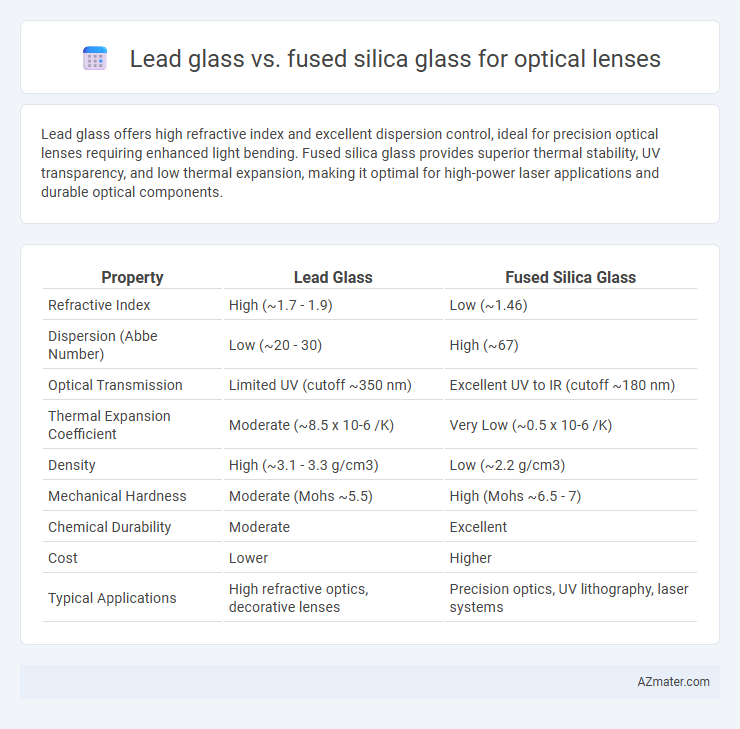Lead glass offers high refractive index and excellent dispersion control, ideal for precision optical lenses requiring enhanced light bending. Fused silica glass provides superior thermal stability, UV transparency, and low thermal expansion, making it optimal for high-power laser applications and durable optical components.
Table of Comparison
| Property | Lead Glass | Fused Silica Glass |
|---|---|---|
| Refractive Index | High (~1.7 - 1.9) | Low (~1.46) |
| Dispersion (Abbe Number) | Low (~20 - 30) | High (~67) |
| Optical Transmission | Limited UV (cutoff ~350 nm) | Excellent UV to IR (cutoff ~180 nm) |
| Thermal Expansion Coefficient | Moderate (~8.5 x 10-6 /K) | Very Low (~0.5 x 10-6 /K) |
| Density | High (~3.1 - 3.3 g/cm3) | Low (~2.2 g/cm3) |
| Mechanical Hardness | Moderate (Mohs ~5.5) | High (Mohs ~6.5 - 7) |
| Chemical Durability | Moderate | Excellent |
| Cost | Lower | Higher |
| Typical Applications | High refractive optics, decorative lenses | Precision optics, UV lithography, laser systems |
Introduction to Optical Lens Materials
Lead glass offers high refractive index and excellent dispersion control, making it suitable for optical lenses requiring enhanced light bending and chromatic aberration correction. Fused silica glass features superior thermal stability, low thermal expansion, and high ultraviolet transparency, ideal for precision optical components exposed to varying environmental conditions. Choosing between lead glass and fused silica depends on balancing optical performance needs with environmental durability and specific wavelength requirements.
Overview of Lead Glass Properties
Lead glass contains high concentrations of lead oxide, typically between 18-40%, which significantly increases its refractive index and density, enhancing light bending and brightness in optical lenses. This glass type exhibits excellent dispersion properties, making it suitable for applications requiring high contrast and brilliance, such as decorative optics and precision lenses. Its relatively lower melting point and ease of shaping give lead glass an advantage in manufacturing complex lens shapes compared to fused silica glass, which is known for superior thermal and chemical stability but lower refractive index.
Key Features of Fused Silica Glass
Fused silica glass exhibits exceptional optical clarity with high transmission across ultraviolet to infrared wavelengths, making it ideal for precision optical lenses. Its superior thermal stability and low coefficient of thermal expansion ensure minimal distortion under temperature fluctuations, outperforming lead glass in demanding environments. Additionally, fused silica offers excellent chemical resistance and durability, contributing to its longevity and consistent optical performance in lenses.
Optical Performance Comparison
Lead glass offers higher refractive indices and superior dispersion control, enhancing lens focusing capabilities and minimizing chromatic aberration in optical systems. Fused silica glass exhibits exceptional optical transparency across ultraviolet to infrared wavelengths and superior thermal stability, making it ideal for high-precision applications where minimal optical distortion is crucial. While lead glass excels in compact lens designs due to its density and refractive properties, fused silica provides unparalleled durability and resistance to thermal and environmental stress, ensuring consistent optical performance over time.
Refractive Index Differences
Lead glass exhibits a higher refractive index, typically ranging from 1.7 to 1.9, which enables stronger light bending and better focusing capabilities in optical lenses compared to fused silica glass. Fused silica glass has a lower refractive index around 1.46, offering superior UV transparency and thermal stability but less optical power enhancement. The significant refractive index difference between lead glass and fused silica influences lens design choices, balancing optical performance with durability requirements.
Transmission Spectra and Wavelength Range
Lead glass exhibits strong transmission in the visible spectrum with high refractive index but suffers from reduced UV transmission below 350 nm, limiting its effectiveness in deep ultraviolet applications. Fused silica glass offers superior transmission across a broad wavelength range, including deep ultraviolet (down to 185 nm), visible, and near-infrared regions, making it ideal for high-purity optical lenses requiring minimal absorption and high damage threshold. The choice between lead glass and fused silica depends on the required wavelength range and application, with fused silica preferred for UV transparency and lead glass favored for higher refractive index needs within the visible spectrum.
Durability and Chemical Resistance
Lead glass offers high refractive index and excellent optical clarity but exhibits lower durability and chemical resistance compared to fused silica glass. Fused silica glass is highly resistant to thermal shock, scratching, and chemical corrosion, making it ideal for harsh or reactive environments in optical applications. The superior mechanical strength and inertness of fused silica ensure longer-lasting performance in lenses exposed to aggressive chemicals and extreme temperature variations.
Cost and Manufacturing Considerations
Lead glass offers a lower material cost and easier molding process compared to fused silica glass, making it economical for mass production of optical lenses. Fused silica glass, although significantly more expensive due to its high purity and complex manufacturing involving high-temperature fusion, provides superior durability and thermal resistance crucial for high-performance optics. Manufacturing lead glass lenses typically involves conventional glass pressing techniques, whereas fused silica requires precision grinding and polishing, resulting in higher labor and equipment costs.
Environmental and Health Impacts
Lead glass contains high levels of lead oxide, which poses significant environmental risks during disposal and manufacturing due to potential lead leaching and toxicity. Fused silica glass is composed of pure silicon dioxide, offering superior environmental safety with minimal health risks because it lacks harmful heavy metals. Optical lenses made from fused silica reduce hazardous waste production and provide a safer alternative for workers and consumers exposed to glass particulates and residues.
Conclusion: Selecting the Ideal Lens Material
Lead glass offers high refractive index and excellent dispersion control, making it suitable for lenses requiring precise chromatic aberration correction in optical systems. Fused silica glass provides superior thermal stability, low thermal expansion, and exceptional UV transparency, ideal for high-power laser and ultraviolet optics. Selecting the ideal lens material depends on application-specific needs such as wavelength range, thermal environment, and optical performance requirements.

Infographic: Lead glass vs Fused silica glass for Optical lens
 azmater.com
azmater.com